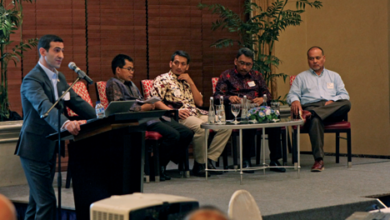RFID technology enables hole section to be drilled, reamed in single trip near Sakhalin Island
Weatherford recently completed a drilling and reaming project near Sakhalin Island, Russia, that resulted in a total time savings of 52 hours.
The operator contracted Weatherford to enlarge a 3,641-ft hole section from 8 ½ to 9 ½ in. on an offshore development well. Weatherford deployed a dual-reamer bottomhole assembly, including a RipTide drilling reamer and a RipTide Rathole Killer drilling reamer. Radio-frequency identification (RFID) tags enabled both reamers to be opened and closed remotely and selectively throughout the run. This method allowed the crew to drill and ream the hole section to a total depth of 14,629 ft, eliminate the rathole and clean the wellbore in a single trip.
By removing the need for a dedicated cleanout trip, which takes an average of 52 hours in this field, the RFID tools produced significant value in terms of time, cost and operational efficiency.
Delmar Quick Release Saves Critical Path time offshore
Delmar has installed and activated the Delmar Quick Release (DQR) on a traditionally moored semisubmersible in the US Gulf of Mexico. Eight DQRs were installed in offshore mooring systems and deployed for more than 160 days in approximately 7,800 ft of water. Through detailed planning and efficient offshore execution, using the DQR resulted in approximately 3.5 days of saved critical path time during disconnection operations.
TRACERCO cuts reservoir stimulation costs by 20%
Tracerco announced that its smart tracer technology has saved operators up to 20% in reservoir stimulation costs over the past few years. Unique tracers are used to tag the native oil, gas and frac water in each of the stages in unconventional wells. Samples are taken at regular intervals and analyzed to allow accurate stage flow data comparison to be made.
In addition, tracers can be used to compare stimulation technologies. One operator tagged two wells with the same geophysical expectations but with two competing stimulation strategies.
The company identified two stages where stimulation was ineffective and discovered that one stimulation strategy yielded 18,000 bbl/month while the other yielded 26,000 bbl/month. If the operator had deleted the ineffective stages, it would have yielded a 20% saving in stimulation costs with only a 4% reduction in production. This allowed the operator to optimize its stimulation strategy.
CentraMax Saves 60% on GOM Casing Centralization
Antelope Oil Tool recently ran the CentraMax RT1 Centralizer in a deviated and underreamed well in 7,000 ft of water in the Gulf of Mexico, saving 60% on casing centralization.
The operator faced a challenging casing string application that required running a deep and heavy 16-in. liner to a record depth. The operator was required to run the 16-in. casing through an 18.25-in. internal diameter restriction at the 18-in. supplemental hanger through an 18.125-in. ID restriction at the 22-in. casing shoe track.
The 16-in. liner was to be run to 24,000-ft and centralized in a 21-in. underreamed hole with 22° of inclination. The liner was a mixed string of 16-ft 97-lb and 16.15-ft 127-lb casing and weighed over 2 million lb. The weight was such that the operator would not have been able to pull out of hole after the shoe reached 19,000-ft, making the centralization critical.
Dissolvable plug-and-perf system eliminates post-stimulation millout in Bakken wells

Schlumberger recently helped Zavanna, a privately held E&P company, to save 50 hours by eliminating post-stimulation plug millouts. The operator wanted to improve efficiency by eliminating the millouts while maintaining the advantages of plug-and-perf completion methods in a 275°F unconventional well in the Bakken in North Dakota. Schlumberger’s Infinity system was deployed. It uses degradable seats instead of plugs to temporarily isolate zones during multistage hydraulic fracturing stimulation.
The system was installed in two wells that were stimulated with a total of 100 stages and placed on flowback. Tough well conditions resulted in two stuck events during the operation, but they were resolved by injecting brine to dissolve the aluminum-base seat material. After a few hours, the tool was free to move, and operations continued with no need for mechanical intervention. After stimulation was completed, Zavanna performed a successful confirmation check to total depth on the first well, validating that the degradation process had occurred as expected.
After the first well, Zavanna chose to eliminate post-stimulation milling, saving 50 hours of operating time. The well was put straight onto production, and initial results showed that both of the wells stimulated using the system matched the productivity of offset wells but did so quicker, with fewer people at the wellsite and with fewer interventions and their associated risks.




